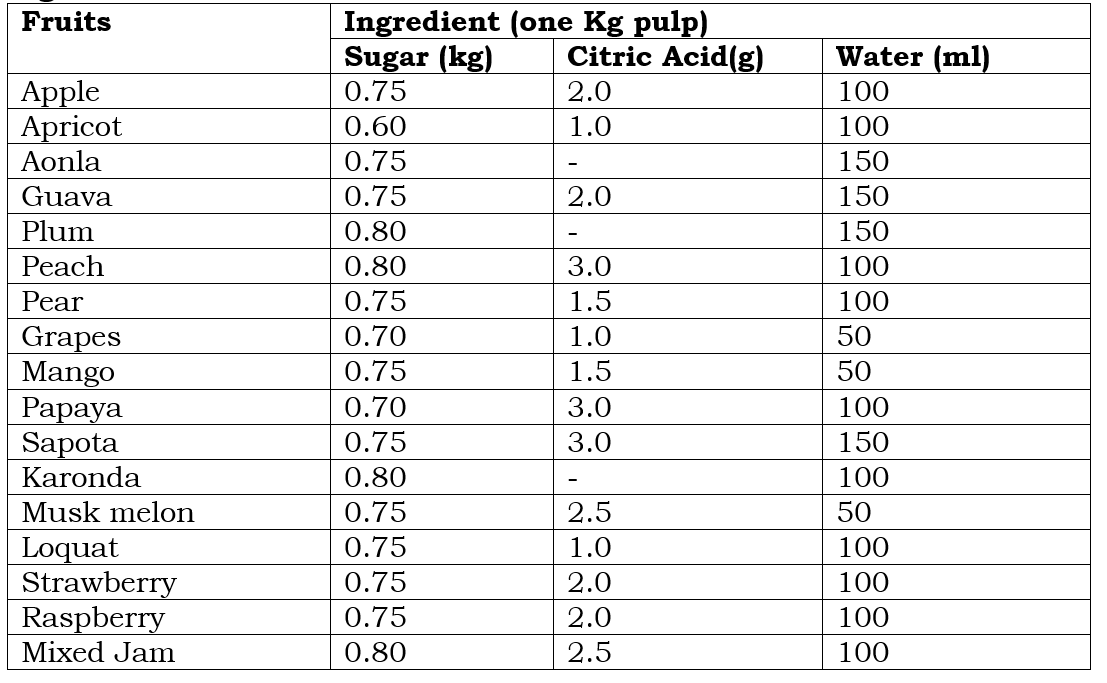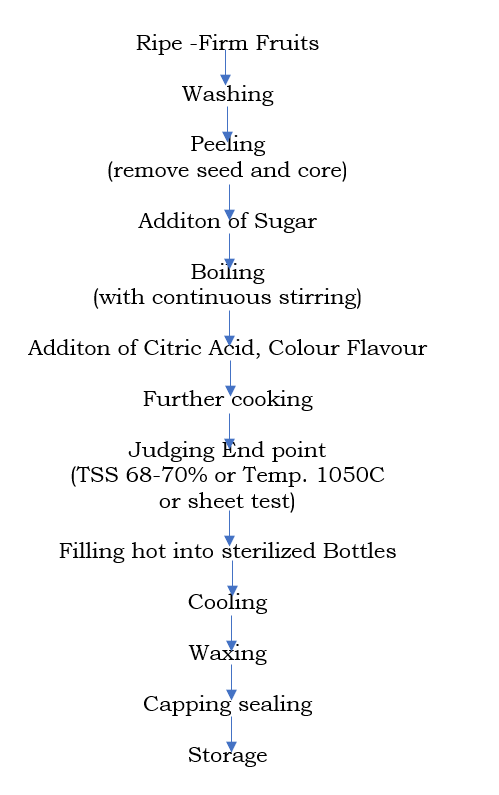Jam is prepared by boiling the fruit pulp with a sufficient amount of sugar to a thick consistency, enough to keep the fruit tissue in that state. It is made from one or two or more types of fruits. According to the FPO specifications, the final product should have TSS not less than 68%, 0.5-0.6% acid, and invert sugar not more than 40%. Fruits suitable for jam are apple, pear, peach, plum, strawberry, raspberry, apricot, loquat, sapota, papaya, mango, karonda, carrot, tomato, grape, cantaloupe, etc.
Watch Lecture Video
Ingredient

Flow sheet for Jam

Jam making process
Preparation of fruits:
The fruits are washed thoroughly to remove any sticking dust and dirt. Then initial treatment of the fruit is done which varies with the type of fruit.
- Strawberries are crushed between rollers; The raspberries are steamed, then crushed, and passed through a sieve to remove the hardcore.
- Plums, peaches, and apricots are heated with a little water until they soften and then passed through a coarse mesh sieve to separate the stones.
- The fruit is boiled in a small amount of water to soften it and then passed through a pulper to remove the pulp.
- The pear is peeled and cut into small pieces.
- Mangoes are peeled, the stones are separated and then the slices are passed through the pulper.
- Pineapple is peeled and cut into small pieces and is passed through screw-type crushers to obtain coarse pulp suitable for making jam.
- When two or more fruits or fruit pulps are mixed in proper proportion to make jam, then the jam is called mixed fruit jam.
Addition of sugar:
55 parts cane sugar (sucrose) for every 45 parts of the fruit is typically used for jam preparation. The finished jam should contain 30 to 50 percent inverted sugar to avoid crystallization of the sugar in the jam during storage. If the percentage of invert sugar (reducing sugar) is less than 30, crystallization occurs in the jam and if it is more than 50%, the jam will develop into a honey-like mass due to the formation of tiny crystals of glucose. Sugar should not be added in excess as jams with high total soluble solids become sticky.
Adding acid, Colours, and Flavour/Essence:
Citric, tartaric, or malic acid is used to complement the acidity of the fruit when making jam. Proper setting of jam requires the addition of acid to acid-deficient fruits to obtain the proper combination of pectin, sugar, and acid. The pH of the fruit juice and pectin mixture should be 3.1 before the sugar is added. Only permitted edible food colours should be used and these should be added at the end of the boiling process. Flavors/essences are added at the end of the cooking process and just before packing.
Boiling/cooking:
The fruit is cooked/boiled in a pan with a small amount of water to obtain the pulp. It is then sufficiently cooked to release its pectin. After adding the sugar, the mixture is boiled again so that the soluble solids are concentrated to about 68.5 percent and the sugar is also inverted to the required amount. Boiling can be done in a steam jacketed kettle or in a stainless steel or aluminum pan. A vacuum pan is used in which the jam is boiled using low temperature (65-750C) and low pressure to minimize unwanted changes and retain the vitamins.
Judging Endpoint:
There are several methods used to determine the endpoint.
- By weight – The weight of the ready jam is taken which is one and a half times (11/2 times) the weight of the sugar used in the weight of the ready jam.
- By TSS – The total soluble solids of ready jam is 68.5% which is detected by the refractometer.
- By Temperature – Jam containing 68.5 percent soluble solids boils at 1050C at sea level. The temperature of boiling jam is measured with a thermometer, when its temperature reaches 1050C, it is considered to be ready.
- Sheet Test – While boiling the jam, take out a little jam in a spoon or wooden spatula and cool it down a bit. After that, it is dropped. If the product falls like a sheet or flakes, it means that the endpoint is reached and the product is considered ready, if it falls as a continuous stream or syrup, it will need to be further cooking.
Storage:
Jam is packaged in sterilized glass jars. It should be noted that the jar should be stored in a very cool place or else the moisture from the jam will evaporate resulting in shrinkage of the jam. If the jam is made from fresh, non-sulfide fruit pulp, it is recommended to add about 40 ppm of sulfur dioxide in the form of potassium meta-by-sulfite to the jam, which is permitted by law. A layer of melted paraffin wax can be applied to the top surface of the cold jam in a glass jar. This acts as protection against any potential molds on the surface of the jam.
Problems in Jam production
(1) Crystallization
The final product should contain 30-50% inverted sugar. If the percentage is less than 30%, cane sugar may crystallize upon storage, and if it is more than 50%, the jam will become a honey-like mass due to the formation of tiny crystals of glucose. Corn syrup or glucose can be mixed with cane sugar to avoid crystallization.
(2) Sticky Jam
Due to the high percentage of total soluble solids, jam tends to be sticky. This problem can be solved by mixing pectin or citric acid, or both.
(3) Premature Setting
This is due to the low soluble solids and high pectin content in jam and can be prevented by adding more sugar. If this cannot be done, a small amount of sodium bicarbonate is added to reduce the acidity and thus prevent pre-coagulation.
(4) Granulation and Shrinkage
This is due to the evaporation of moisture during the storage of the jam. It can be reduced by keeping it in a cool place.
(5) Microbial Spoilage
Sometimes mold can spoil the jam during storage due to storage at high humidity. Therefore, the jam should be stored at 80% humidity. Mold growth can be prevented by not sealing a filled jar and covering the surface of the jam with wax because mold does not grow as rapidly in open conditions as in a closed and sealed space. It is also recommended to add 40ppm Sulfur Dioxide as KMS. If the can is being used for packing, sulfur dioxide should not be added to the jam as it darkens the inner surface of the can. Due to the high concentration of sugar yeast is not a serious problem.
